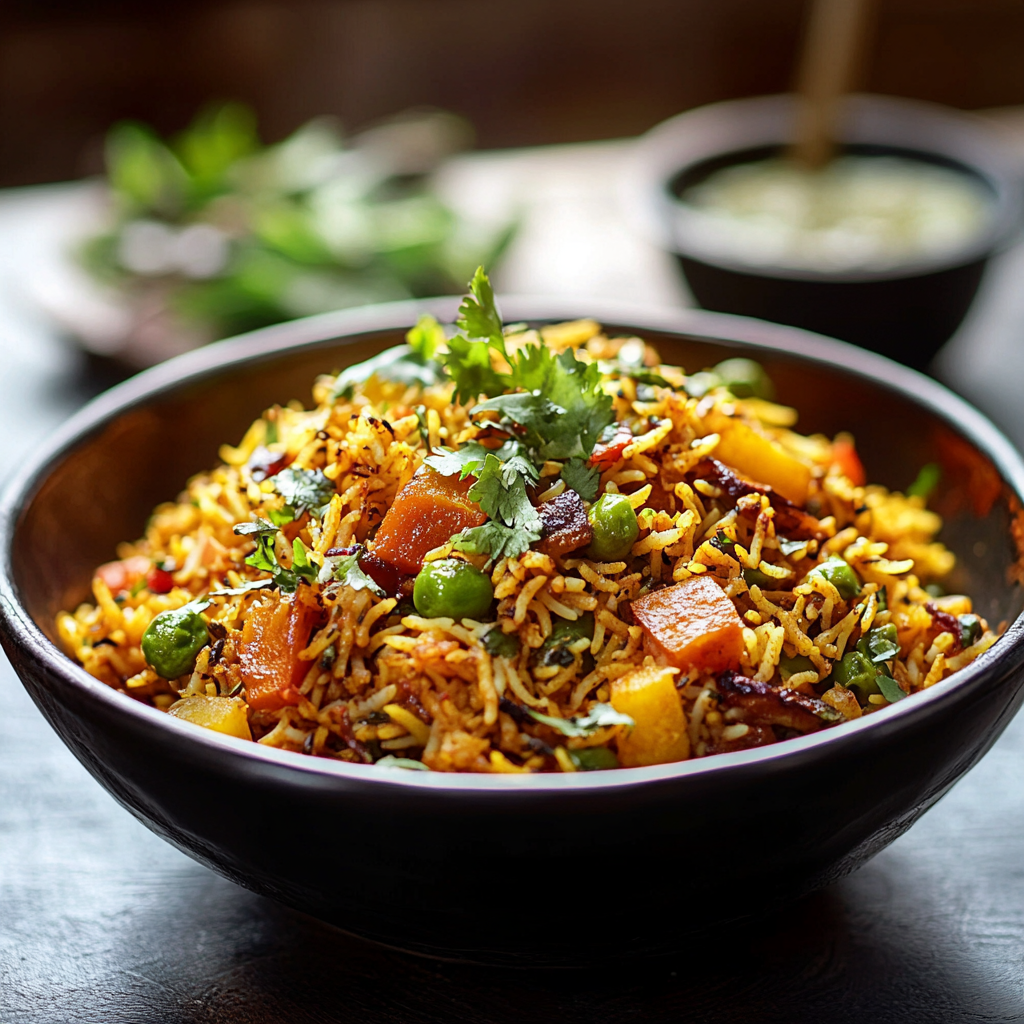Have you ever craved a dish that’s bursting with flavor and color? Vegetable biryani is not just a meal; it’s an experience that captivates your senses. Imagine fragrant basmati rice layered with colorful vegetables, aromatic spices, and a hint of saffron. Each bite offers a delightful crunch from the veggies combined with tender grains that melt in your mouth.
This dish is perfect for gatherings or cozy family dinners. The enticing aroma wafts through the air as it cooks, inviting everyone to the table. With its rich flavors and vibrant colors, vegetable biryani is sure to impress your guests while providing a comforting meal for any occasion. Get ready to embark on a culinary adventure!
Why You’ll Love This Vegetable Biryani
Flavor Explosion: This vegetable biryani combines an array of spices such as cumin, cardamom, and cinnamon. The result is a multi-layered flavor profile that delights your palate with every forkful. The fresh vegetables add natural sweetness and texture that enhance the overall experience.
Healthy and Wholesome: Packed with nutrient-rich vegetables like carrots, peas, and bell peppers, this dish provides essential vitamins and minerals. It’s a nourishing option for anyone looking to enjoy a delicious meal without compromising on health.
Easy One-Pot Meal: Preparing vegetable biryani is simple and convenient since it all comes together in one pot. This saves time on cooking and cleanup while allowing you to focus on enjoying your meal with loved ones.
Customizable Delight: You can easily make this dish your own by adding seasonal vegetables or adjusting spice levels to suit your taste preferences. Whether you prefer it mild or spicy, vegetable biryani accommodates everyone’s cravings.
Ingredients
Here’s what you’ll need to make this delicious dish:
- Basmati Rice: Use 2 cups of long-grain basmati rice for its unique fragrance and fluffy texture when cooked.
- Mixed Vegetables: About 2 cups of chopped carrots, peas, green beans, and bell peppers provide color and nutrition.
- Onion: One large onion sliced thinly adds sweetness when caramelized.
- Garlic and Ginger Paste: A tablespoon each of garlic and ginger paste enhances the flavor profile significantly.
- Spices: Include whole spices like cumin seeds, bay leaves, cloves, cardamom pods, and cinnamon sticks for aroma.
- Saffron or Turmeric: A pinch of saffron soaked in warm water or a teaspoon of turmeric adds color and richness.
- Vegetable Broth or Water: Use about four cups for cooking the rice to infuse additional flavor.
The full ingredients list, including measurements, is provided in the recipe card directly below.
How to Make Vegetable Biryani
Follow these simple steps to prepare this delicious dish:
Rinse the Rice: Begin by rinsing the basmati rice under cold water until it runs clear. This step removes excess starch and prevents stickiness during cooking.
Sauté Aromatics: In a large pot or pressure cooker over medium heat, add some oil or ghee. Once hot, sauté sliced onions until they turn golden brown. Add garlic-ginger paste followed by whole spices allowing them to release their flavors.
Add Vegetables: Stir in the chopped mixed vegetables along with salt. Sauté them for about five minutes until they start to soften but remain crisp.
Add Rice and Broth: Carefully fold in the rinsed basmati rice into the pot. Pour in four cups of vegetable broth or water along with saffron or turmeric if using.
Cook the Biryani: Bring everything to a boil then reduce heat to low; cover tightly with a lid. Allow it to simmer for about 20-25 minutes until all liquid is absorbed.
Serve Hot: Once cooked, fluff the biryani gently with a fork before serving. Transfer it onto plates while garnishing with fresh cilantro or fried onions if desired.

Tips and Tricks
Here are some helpful tips to ensure the best results for your dish:
Use Quality Rice: For optimal texture and flavor, use high-quality basmati rice as it makes all the difference in achieving fluffy grains.
Adjust Spice Levels: If you’re sensitive to heat but still want flavor, reduce the amount of whole spices used while maintaining essential seasonings.
Add Nuts for Crunch: Consider tossing in toasted cashews or almonds before serving; they provide an enjoyable crunch that contrasts beautifully against soft grains.
Let It Rest Before Serving: After cooking finishes, letting the biryani rest covered for at least ten minutes allows flavors to meld together even more beautifully.
Garnish Creatively: Elevate presentation by garnishing servings with fresh herbs like mint or cilantro alongside yogurt on top for added creaminess.
By following these guidelines step-by-step throughout making your own flavorful vegetable biryani at home!
Mistakes to avoid
Not Rinsing the Rice
One of the most common mistakes when preparing Vegetable Biryani is failing to rinse the rice. Washing the rice before cooking removes excess starch, preventing it from becoming sticky. This ensures that each grain remains distinct and fluffy. Rinse the rice under cold water until the water runs clear. This process takes about 3-5 minutes and significantly enhances the texture of your final dish. Neglecting this step can lead to a clumpy and unappealing biryani.
Overcooking the Vegetables
Another mistake is overcooking the vegetables included in your Vegetable Biryani. While you want them tender, overcooking can result in mushy pieces that lose their flavor and nutritional value. To achieve the perfect texture, sauté the vegetables until they are just tender but still crisp, which usually takes about 5-7 minutes on medium heat. Remember that they will continue to cook during the steaming process, so aim for a slight crunch for the best results.
Ignoring Spice Quality
Using old or low-quality spices greatly affects the flavor profile of your Vegetable Biryani. Fresh spices release more aroma and taste, elevating your dish significantly. Always check expiration dates and opt for whole spices when possible, as they retain their flavor longer than pre-ground options. Toasting spices before use can also enhance their potency; simply heat them in a dry pan for about 1-2 minutes until fragrant for a richer taste.
Skipping Layering Technique
Failing to layer ingredients correctly is a prevalent mistake in making Vegetable Biryani. Proper layering allows flavors to meld beautifully during cooking. Start with a base of partially cooked rice, then add marinated vegetables and any additional seasonings or herbs before topping with more rice. This technique typically requires about 10 minutes of careful assembly but pays off with improved flavor distribution throughout the dish, resulting in an authentic biryani experience.
Serving Suggestions
This Vegetable Biryani is versatile and pairs wonderfully with a variety of side dishes. You can serve it with a cooling cucumber raita, which enhances the flavors and adds a refreshing element. The creamy yogurt-based raita complements the spices in the biryani beautifully. Consider pairing it with a tangy mint chutney for an extra kick; the freshness of mint cuts through the richness of the dish nicely. Another excellent option is to serve it alongside crispy papadums, which provide a delightful crunch and contrast in texture. Finally, a simple salad made with diced tomatoes, onions, and lemon juice can brighten up your meal and add a fresh touch.

FAQs
What is Vegetable Biryani made of?
Vegetable Biryani typically consists of basmati rice layered with a mix of seasonal vegetables and aromatic spices. Common ingredients include carrots, peas, potatoes, and bell peppers, all cooked together to infuse maximum flavor. The dish often features fragrant spices such as cumin, coriander, and garam masala, which contribute to its unique taste profile. Adding herbs like cilantro or mint enhances its freshness.
Can I make Vegetable Biryani ahead of time?
Yes, you can prepare Vegetable Biryani ahead of time. To do this, cook the biryani fully and let it cool before storing it in an airtight container in the refrigerator. It can last for up to three days when properly stored. Reheat it on the stovetop or microwave before serving, adding a splash of water to maintain moisture and prevent drying out.
Is Vegetable Biryani suitable for vegetarians?
Absolutely! Vegetable Biryani is inherently vegetarian as it features only vegetables and spices without any meat or fish products. This makes it an excellent choice for vegetarians looking for a hearty meal that is both nutritious and satisfying. You can also modify the recipe by adding your favorite vegetables according to your taste preferences.
How spicy is Vegetable Biryani?
The spiciness of Vegetable Biryani can vary based on personal preference and the amount of spices used. Generally, it’s mildly spicy due to the use of aromatic spices like cumin and coriander. If you prefer a hotter version, you can increase the amount of green chilies or add red chili powder during cooking. Adjusting spice levels allows everyone to enjoy this flavorful dish.
Conclusion
In summary, Vegetable Biryani is a vibrant and flavorful dish that brings together basmati rice and an array of fresh vegetables enhanced by aromatic spices. It’s perfect for any meal occasion and offers various serving options that elevate its appeal. Pairing it with cooling sides like raita or tangy chutneys enhances its taste while providing balance to its rich flavors. Preparing this dish ahead allows for convenience without sacrificing quality; simply reheat before serving. Additionally, its versatility makes it suitable for vegetarians while allowing customization based on individual spice preferences. Enjoy making this delightful dish that promises satisfaction at every bite!

Vegetable Biryani
- Total Time: 40 minutes
- Yield: Serves 4
Description
Dive into the rich and aromatic world of Vegetable Biryani, a vibrant dish that layers fluffy basmati rice with an array of colorful vegetables and fragrant spices. This one-pot meal is perfect for any occasion, from family dinners to festive gatherings. The harmonious blend of spices like cumin, cardamom, and saffron creates a delightful flavor symphony that will captivate your taste buds. Not only is it delicious, but it’s also packed with nutrients from fresh vegetables such as carrots, peas, and bell peppers. With its simplicity and endless customization options, Vegetable Biryani is destined to become a staple in your kitchen.
Ingredients
- 2 cups basmati rice
- 2 cups mixed vegetables (carrots, peas, green beans, bell peppers)
- 1 large onion (sliced)
- 1 tablespoon garlic-ginger paste
- Whole spices (cumin seeds, bay leaves, cloves, cardamom pods, cinnamon sticks)
- Pinch of saffron or 1 teaspoon turmeric
- 4 cups vegetable broth or water
- Salt to taste
Instructions
- Rinse the basmati rice under cold water until it runs clear to remove excess starch.
- In a large pot or pressure cooker over medium heat, add oil or ghee and sauté sliced onions until golden brown.
- Stir in garlic-ginger paste and whole spices for about one minute until fragrant.
- Add mixed vegetables with salt; sauté for about five minutes until slightly softened.
- Fold in the rinsed rice and pour in the vegetable broth or water along with saffron or turmeric if using.
- Bring to a boil; then reduce heat to low, cover tightly, and simmer for 20-25 minutes until liquid is absorbed.
- Fluff gently with a fork before serving hot.
- Prep Time: 15 minutes
- Cook Time: 25 minutes
- Category: Main
- Method: One-Pot Cooking
- Cuisine: Indian
Nutrition
- Serving Size: 1 cup (200g)
- Calories: 250
- Sugar: 3g
- Sodium: 500mg
- Fat: 5g
- Saturated Fat: 1g
- Unsaturated Fat: 3g
- Trans Fat: 0g
- Carbohydrates: 45g
- Fiber: 5g
- Protein: 7g
- Cholesterol: 0mg

